Criminology Report: Youth Violence, Gangs, and Policing in Britain
VerifiedAdded on 2020/05/28
|13
|3584
|145
Report
AI Summary
This criminology report investigates the complex interplay between youth violence, gangs, and racialization in 21st-century Britain, focusing on the roles of police and media. The research explores how gangs and youth violence are associated with cultures and friendship groups of urban and black youth by new media and police, leading to the criminalization of innocent black youth through police targeting. The report examines the historical context of racial themes and crime, the rationale for the research, and the aims, objectives, and research questions. It utilizes a secondary research methodology, justifying the use of secondary data collection methods, including books, articles, and journals. The report also addresses research limitations and ethical considerations. It analyzes the challenges faced by police in deterring crime, working across borders, and engaging with diverse communities, while also highlighting the impact of media portrayals on public perception and the criminal justice system.

Running head: CRIMINOLOGY
Criminology
Name of the Student
Name of the University
Author Note
Criminology
Name of the Student
Name of the University
Author Note
Paraphrase This Document
Need a fresh take? Get an instant paraphrase of this document with our AI Paraphraser
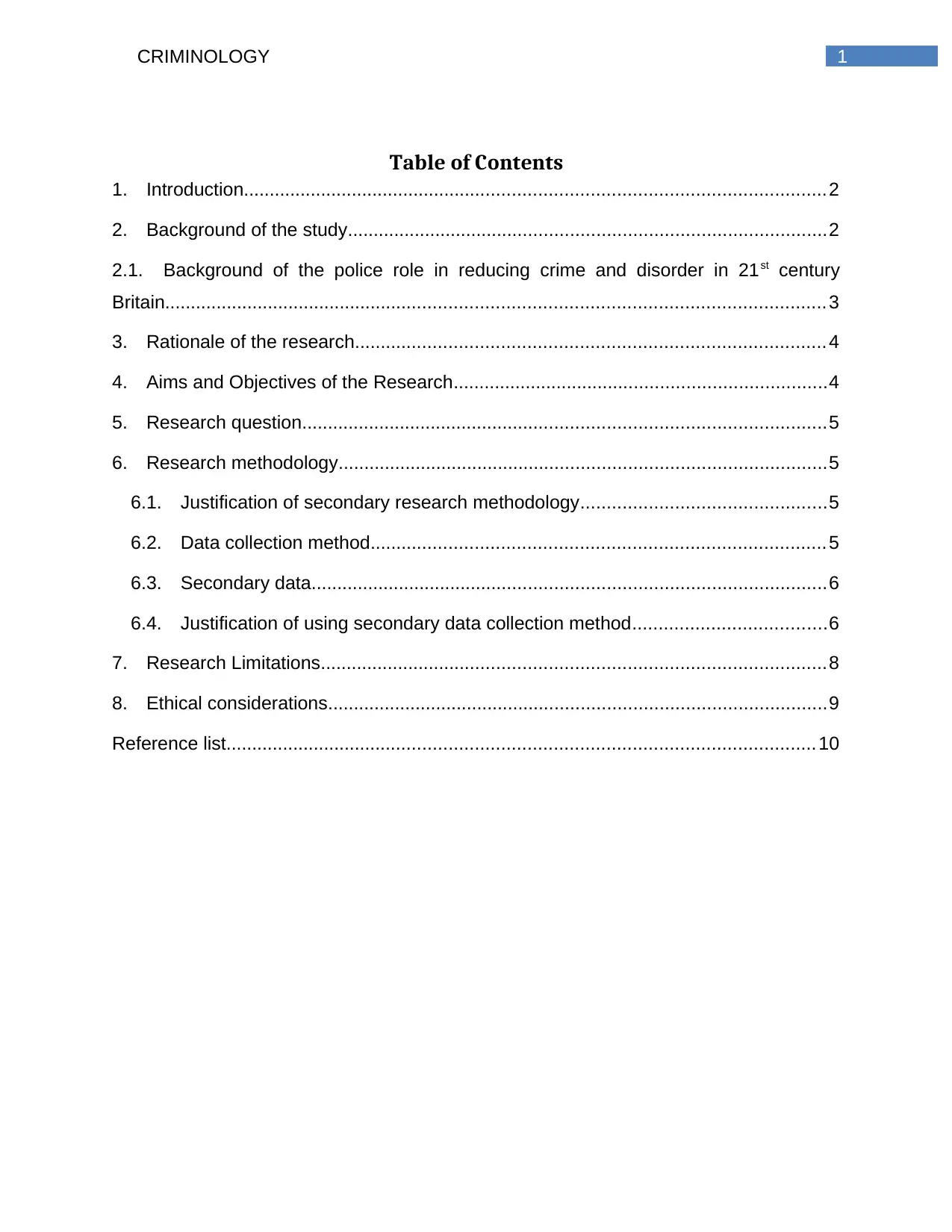
1CRIMINOLOGY
Table of Contents
1. Introduction................................................................................................................2
2. Background of the study............................................................................................2
2.1. Background of the police role in reducing crime and disorder in 21st century
Britain............................................................................................................................... 3
3. Rationale of the research.......................................................................................... 4
4. Aims and Objectives of the Research........................................................................4
5. Research question.....................................................................................................5
6. Research methodology..............................................................................................5
6.1. Justification of secondary research methodology...............................................5
6.2. Data collection method....................................................................................... 5
6.3. Secondary data...................................................................................................6
6.4. Justification of using secondary data collection method.....................................6
7. Research Limitations.................................................................................................8
8. Ethical considerations................................................................................................9
Reference list................................................................................................................. 10
Table of Contents
1. Introduction................................................................................................................2
2. Background of the study............................................................................................2
2.1. Background of the police role in reducing crime and disorder in 21st century
Britain............................................................................................................................... 3
3. Rationale of the research.......................................................................................... 4
4. Aims and Objectives of the Research........................................................................4
5. Research question.....................................................................................................5
6. Research methodology..............................................................................................5
6.1. Justification of secondary research methodology...............................................5
6.2. Data collection method....................................................................................... 5
6.3. Secondary data...................................................................................................6
6.4. Justification of using secondary data collection method.....................................6
7. Research Limitations.................................................................................................8
8. Ethical considerations................................................................................................9
Reference list................................................................................................................. 10
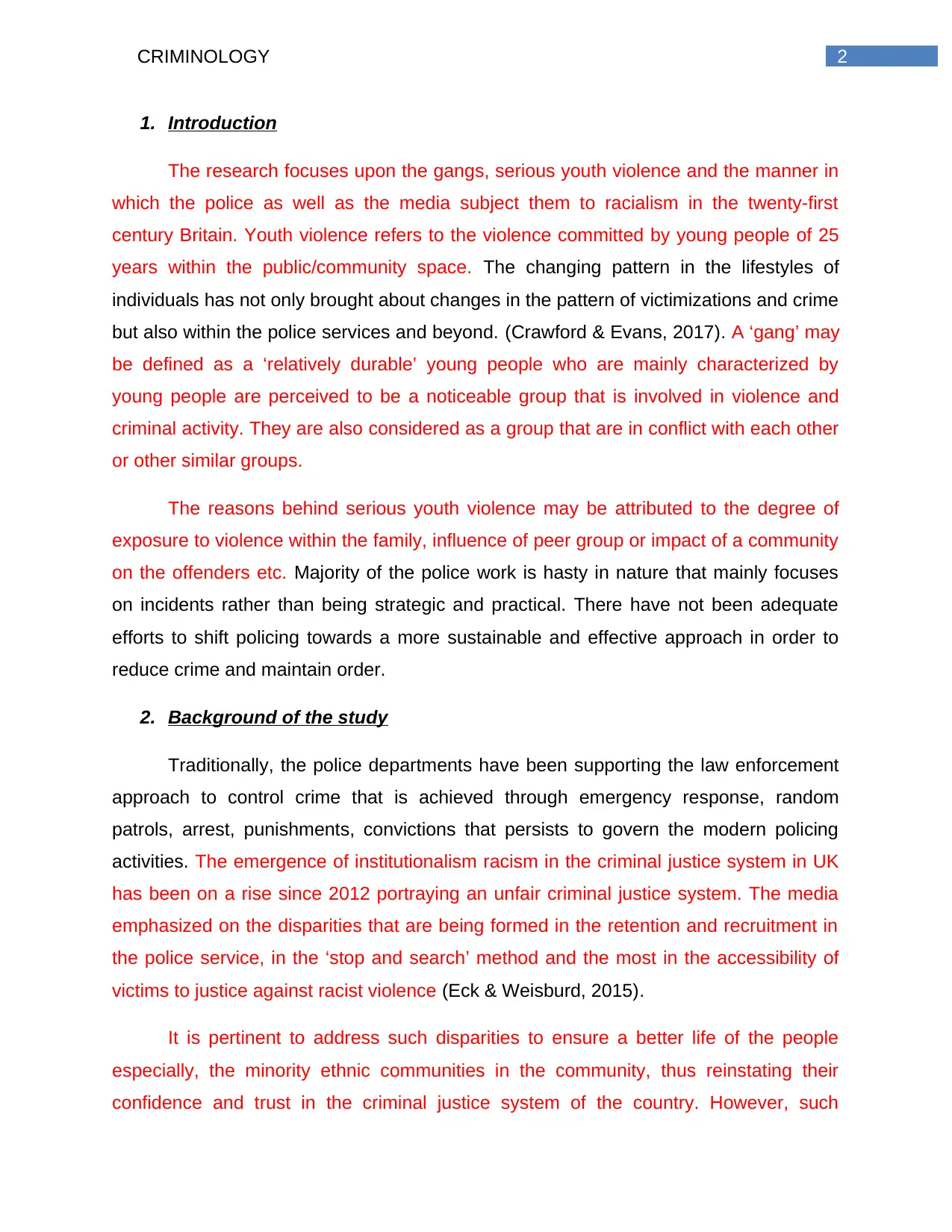
2CRIMINOLOGY
1. Introduction
The research focuses upon the gangs, serious youth violence and the manner in
which the police as well as the media subject them to racialism in the twenty-first
century Britain. Youth violence refers to the violence committed by young people of 25
years within the public/community space. The changing pattern in the lifestyles of
individuals has not only brought about changes in the pattern of victimizations and crime
but also within the police services and beyond. (Crawford & Evans, 2017). A ‘gang’ may
be defined as a ‘relatively durable’ young people who are mainly characterized by
young people are perceived to be a noticeable group that is involved in violence and
criminal activity. They are also considered as a group that are in conflict with each other
or other similar groups.
The reasons behind serious youth violence may be attributed to the degree of
exposure to violence within the family, influence of peer group or impact of a community
on the offenders etc. Majority of the police work is hasty in nature that mainly focuses
on incidents rather than being strategic and practical. There have not been adequate
efforts to shift policing towards a more sustainable and effective approach in order to
reduce crime and maintain order.
2. Background of the study
Traditionally, the police departments have been supporting the law enforcement
approach to control crime that is achieved through emergency response, random
patrols, arrest, punishments, convictions that persists to govern the modern policing
activities. The emergence of institutionalism racism in the criminal justice system in UK
has been on a rise since 2012 portraying an unfair criminal justice system. The media
emphasized on the disparities that are being formed in the retention and recruitment in
the police service, in the ‘stop and search’ method and the most in the accessibility of
victims to justice against racist violence (Eck & Weisburd, 2015).
It is pertinent to address such disparities to ensure a better life of the people
especially, the minority ethnic communities in the community, thus reinstating their
confidence and trust in the criminal justice system of the country. However, such
1. Introduction
The research focuses upon the gangs, serious youth violence and the manner in
which the police as well as the media subject them to racialism in the twenty-first
century Britain. Youth violence refers to the violence committed by young people of 25
years within the public/community space. The changing pattern in the lifestyles of
individuals has not only brought about changes in the pattern of victimizations and crime
but also within the police services and beyond. (Crawford & Evans, 2017). A ‘gang’ may
be defined as a ‘relatively durable’ young people who are mainly characterized by
young people are perceived to be a noticeable group that is involved in violence and
criminal activity. They are also considered as a group that are in conflict with each other
or other similar groups.
The reasons behind serious youth violence may be attributed to the degree of
exposure to violence within the family, influence of peer group or impact of a community
on the offenders etc. Majority of the police work is hasty in nature that mainly focuses
on incidents rather than being strategic and practical. There have not been adequate
efforts to shift policing towards a more sustainable and effective approach in order to
reduce crime and maintain order.
2. Background of the study
Traditionally, the police departments have been supporting the law enforcement
approach to control crime that is achieved through emergency response, random
patrols, arrest, punishments, convictions that persists to govern the modern policing
activities. The emergence of institutionalism racism in the criminal justice system in UK
has been on a rise since 2012 portraying an unfair criminal justice system. The media
emphasized on the disparities that are being formed in the retention and recruitment in
the police service, in the ‘stop and search’ method and the most in the accessibility of
victims to justice against racist violence (Eck & Weisburd, 2015).
It is pertinent to address such disparities to ensure a better life of the people
especially, the minority ethnic communities in the community, thus reinstating their
confidence and trust in the criminal justice system of the country. However, such
⊘ This is a preview!⊘
Do you want full access?
Subscribe today to unlock all pages.

Trusted by 1+ million students worldwide
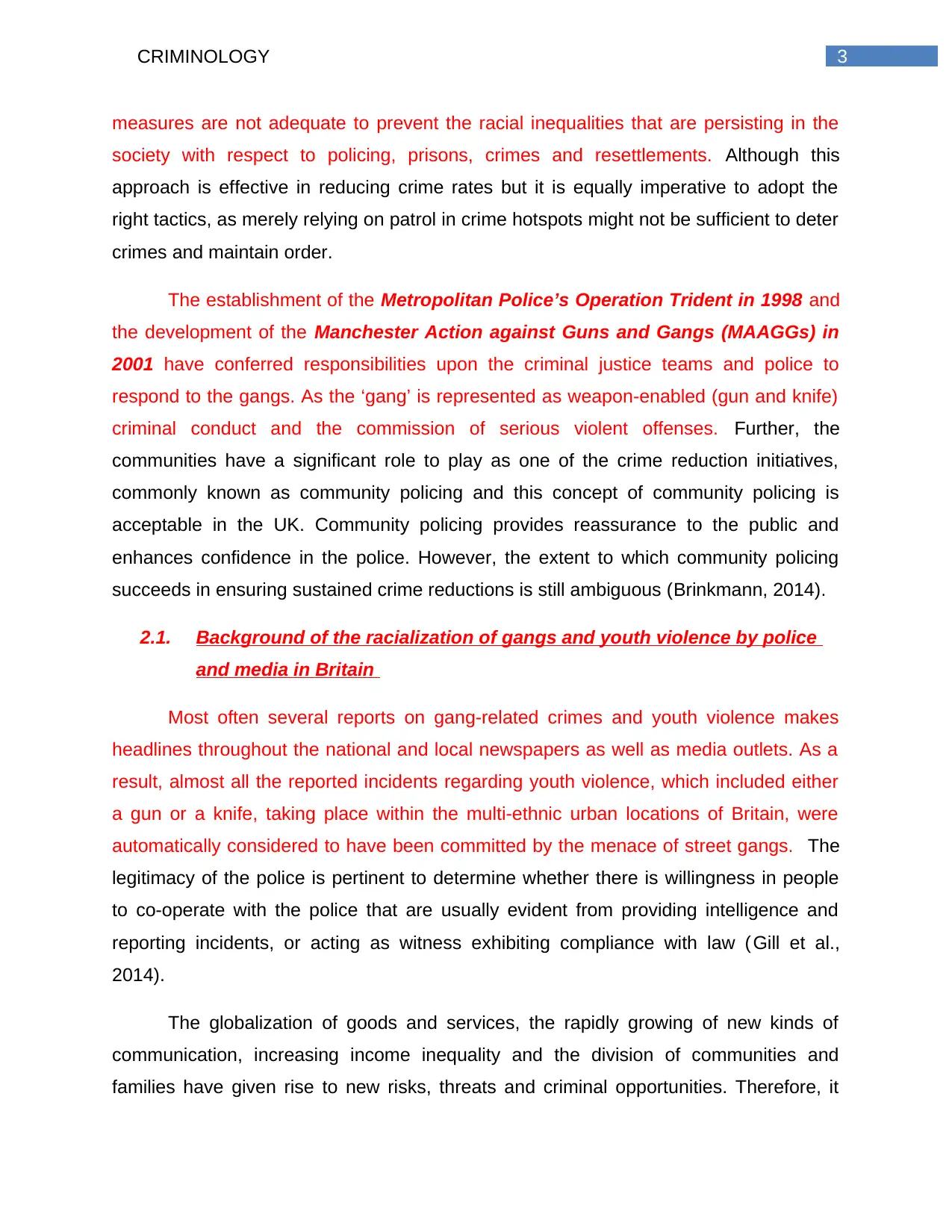
3CRIMINOLOGY
measures are not adequate to prevent the racial inequalities that are persisting in the
society with respect to policing, prisons, crimes and resettlements. Although this
approach is effective in reducing crime rates but it is equally imperative to adopt the
right tactics, as merely relying on patrol in crime hotspots might not be sufficient to deter
crimes and maintain order.
The establishment of the Metropolitan Police’s Operation Trident in 1998 and
the development of the Manchester Action against Guns and Gangs (MAAGGs) in
2001 have conferred responsibilities upon the criminal justice teams and police to
respond to the gangs. As the ‘gang’ is represented as weapon-enabled (gun and knife)
criminal conduct and the commission of serious violent offenses. Further, the
communities have a significant role to play as one of the crime reduction initiatives,
commonly known as community policing and this concept of community policing is
acceptable in the UK. Community policing provides reassurance to the public and
enhances confidence in the police. However, the extent to which community policing
succeeds in ensuring sustained crime reductions is still ambiguous (Brinkmann, 2014).
2.1. Background of the racialization of gangs and youth violence by police
and media in Britain
Most often several reports on gang-related crimes and youth violence makes
headlines throughout the national and local newspapers as well as media outlets. As a
result, almost all the reported incidents regarding youth violence, which included either
a gun or a knife, taking place within the multi-ethnic urban locations of Britain, were
automatically considered to have been committed by the menace of street gangs. The
legitimacy of the police is pertinent to determine whether there is willingness in people
to co-operate with the police that are usually evident from providing intelligence and
reporting incidents, or acting as witness exhibiting compliance with law (Gill et al.,
2014).
The globalization of goods and services, the rapidly growing of new kinds of
communication, increasing income inequality and the division of communities and
families have given rise to new risks, threats and criminal opportunities. Therefore, it
measures are not adequate to prevent the racial inequalities that are persisting in the
society with respect to policing, prisons, crimes and resettlements. Although this
approach is effective in reducing crime rates but it is equally imperative to adopt the
right tactics, as merely relying on patrol in crime hotspots might not be sufficient to deter
crimes and maintain order.
The establishment of the Metropolitan Police’s Operation Trident in 1998 and
the development of the Manchester Action against Guns and Gangs (MAAGGs) in
2001 have conferred responsibilities upon the criminal justice teams and police to
respond to the gangs. As the ‘gang’ is represented as weapon-enabled (gun and knife)
criminal conduct and the commission of serious violent offenses. Further, the
communities have a significant role to play as one of the crime reduction initiatives,
commonly known as community policing and this concept of community policing is
acceptable in the UK. Community policing provides reassurance to the public and
enhances confidence in the police. However, the extent to which community policing
succeeds in ensuring sustained crime reductions is still ambiguous (Brinkmann, 2014).
2.1. Background of the racialization of gangs and youth violence by police
and media in Britain
Most often several reports on gang-related crimes and youth violence makes
headlines throughout the national and local newspapers as well as media outlets. As a
result, almost all the reported incidents regarding youth violence, which included either
a gun or a knife, taking place within the multi-ethnic urban locations of Britain, were
automatically considered to have been committed by the menace of street gangs. The
legitimacy of the police is pertinent to determine whether there is willingness in people
to co-operate with the police that are usually evident from providing intelligence and
reporting incidents, or acting as witness exhibiting compliance with law (Gill et al.,
2014).
The globalization of goods and services, the rapidly growing of new kinds of
communication, increasing income inequality and the division of communities and
families have given rise to new risks, threats and criminal opportunities. Therefore, it
Paraphrase This Document
Need a fresh take? Get an instant paraphrase of this document with our AI Paraphraser
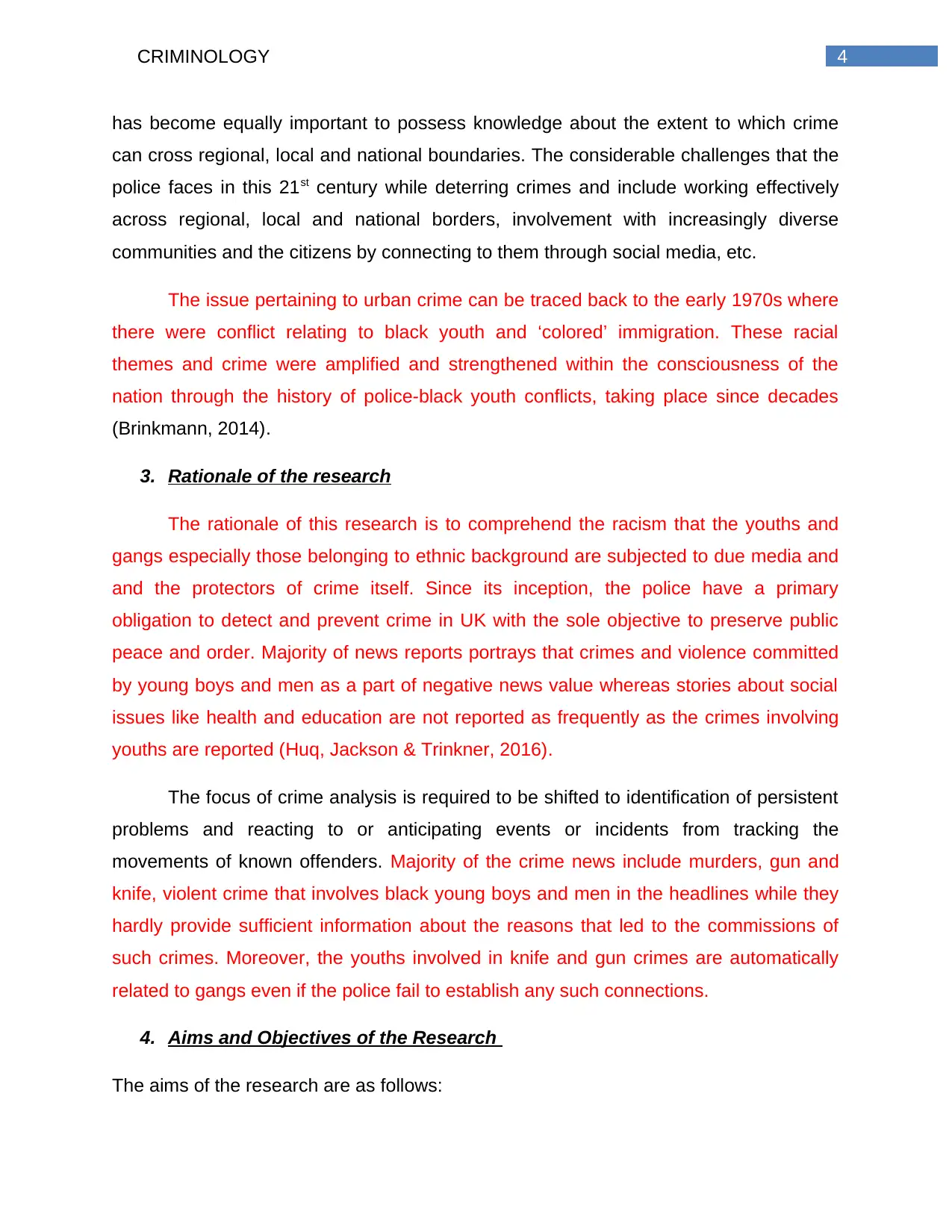
4CRIMINOLOGY
has become equally important to possess knowledge about the extent to which crime
can cross regional, local and national boundaries. The considerable challenges that the
police faces in this 21st century while deterring crimes and include working effectively
across regional, local and national borders, involvement with increasingly diverse
communities and the citizens by connecting to them through social media, etc.
The issue pertaining to urban crime can be traced back to the early 1970s where
there were conflict relating to black youth and ‘colored’ immigration. These racial
themes and crime were amplified and strengthened within the consciousness of the
nation through the history of police-black youth conflicts, taking place since decades
(Brinkmann, 2014).
3. Rationale of the research
The rationale of this research is to comprehend the racism that the youths and
gangs especially those belonging to ethnic background are subjected to due media and
and the protectors of crime itself. Since its inception, the police have a primary
obligation to detect and prevent crime in UK with the sole objective to preserve public
peace and order. Majority of news reports portrays that crimes and violence committed
by young boys and men as a part of negative news value whereas stories about social
issues like health and education are not reported as frequently as the crimes involving
youths are reported (Huq, Jackson & Trinkner, 2016).
The focus of crime analysis is required to be shifted to identification of persistent
problems and reacting to or anticipating events or incidents from tracking the
movements of known offenders. Majority of the crime news include murders, gun and
knife, violent crime that involves black young boys and men in the headlines while they
hardly provide sufficient information about the reasons that led to the commissions of
such crimes. Moreover, the youths involved in knife and gun crimes are automatically
related to gangs even if the police fail to establish any such connections.
4. Aims and Objectives of the Research
The aims of the research are as follows:
has become equally important to possess knowledge about the extent to which crime
can cross regional, local and national boundaries. The considerable challenges that the
police faces in this 21st century while deterring crimes and include working effectively
across regional, local and national borders, involvement with increasingly diverse
communities and the citizens by connecting to them through social media, etc.
The issue pertaining to urban crime can be traced back to the early 1970s where
there were conflict relating to black youth and ‘colored’ immigration. These racial
themes and crime were amplified and strengthened within the consciousness of the
nation through the history of police-black youth conflicts, taking place since decades
(Brinkmann, 2014).
3. Rationale of the research
The rationale of this research is to comprehend the racism that the youths and
gangs especially those belonging to ethnic background are subjected to due media and
and the protectors of crime itself. Since its inception, the police have a primary
obligation to detect and prevent crime in UK with the sole objective to preserve public
peace and order. Majority of news reports portrays that crimes and violence committed
by young boys and men as a part of negative news value whereas stories about social
issues like health and education are not reported as frequently as the crimes involving
youths are reported (Huq, Jackson & Trinkner, 2016).
The focus of crime analysis is required to be shifted to identification of persistent
problems and reacting to or anticipating events or incidents from tracking the
movements of known offenders. Majority of the crime news include murders, gun and
knife, violent crime that involves black young boys and men in the headlines while they
hardly provide sufficient information about the reasons that led to the commissions of
such crimes. Moreover, the youths involved in knife and gun crimes are automatically
related to gangs even if the police fail to establish any such connections.
4. Aims and Objectives of the Research
The aims of the research are as follows:
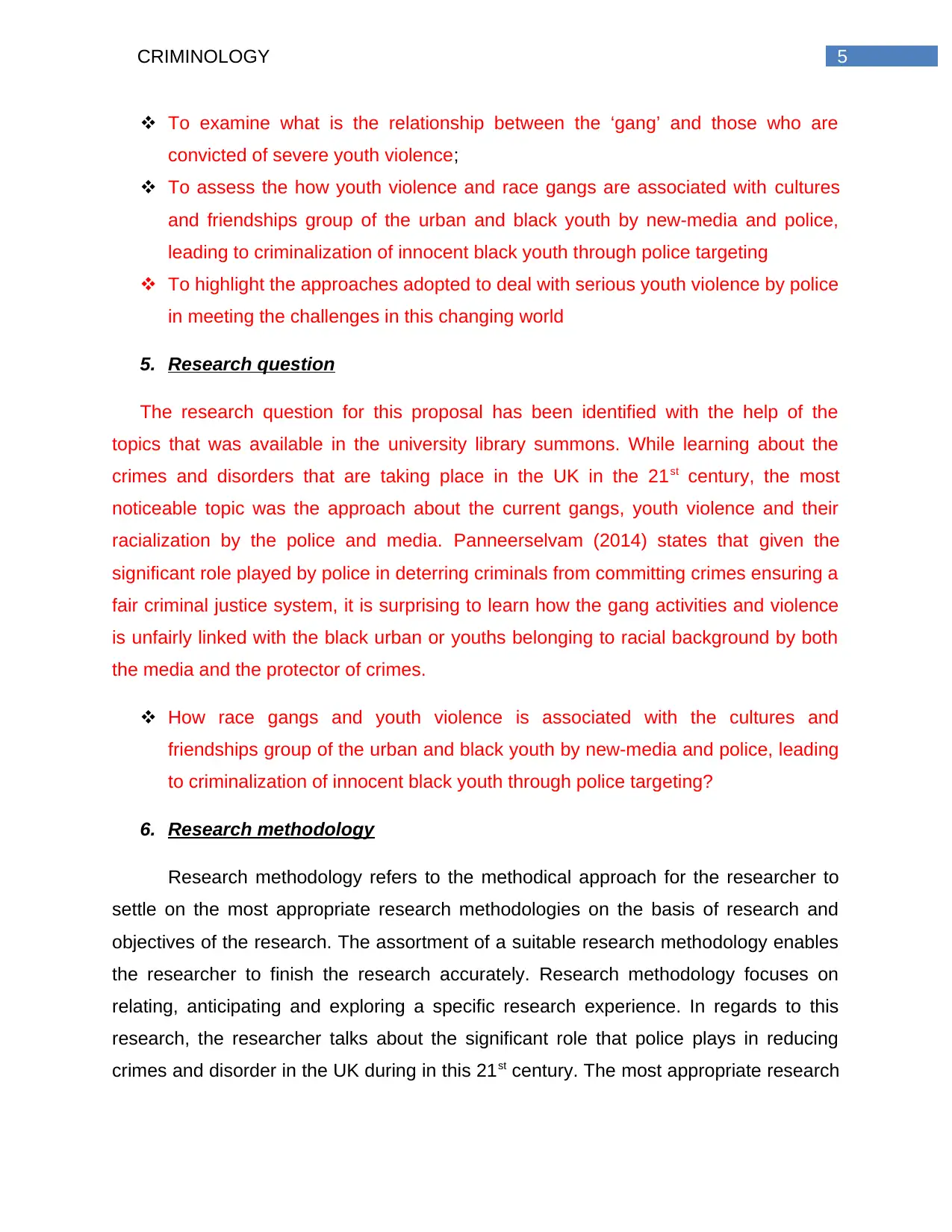
5CRIMINOLOGY
To examine what is the relationship between the ‘gang’ and those who are
convicted of severe youth violence;
To assess the how youth violence and race gangs are associated with cultures
and friendships group of the urban and black youth by new-media and police,
leading to criminalization of innocent black youth through police targeting
To highlight the approaches adopted to deal with serious youth violence by police
in meeting the challenges in this changing world
5. Research question
The research question for this proposal has been identified with the help of the
topics that was available in the university library summons. While learning about the
crimes and disorders that are taking place in the UK in the 21st century, the most
noticeable topic was the approach about the current gangs, youth violence and their
racialization by the police and media. Panneerselvam (2014) states that given the
significant role played by police in deterring criminals from committing crimes ensuring a
fair criminal justice system, it is surprising to learn how the gang activities and violence
is unfairly linked with the black urban or youths belonging to racial background by both
the media and the protector of crimes.
How race gangs and youth violence is associated with the cultures and
friendships group of the urban and black youth by new-media and police, leading
to criminalization of innocent black youth through police targeting?
6. Research methodology
Research methodology refers to the methodical approach for the researcher to
settle on the most appropriate research methodologies on the basis of research and
objectives of the research. The assortment of a suitable research methodology enables
the researcher to finish the research accurately. Research methodology focuses on
relating, anticipating and exploring a specific research experience. In regards to this
research, the researcher talks about the significant role that police plays in reducing
crimes and disorder in the UK during in this 21st century. The most appropriate research
To examine what is the relationship between the ‘gang’ and those who are
convicted of severe youth violence;
To assess the how youth violence and race gangs are associated with cultures
and friendships group of the urban and black youth by new-media and police,
leading to criminalization of innocent black youth through police targeting
To highlight the approaches adopted to deal with serious youth violence by police
in meeting the challenges in this changing world
5. Research question
The research question for this proposal has been identified with the help of the
topics that was available in the university library summons. While learning about the
crimes and disorders that are taking place in the UK in the 21st century, the most
noticeable topic was the approach about the current gangs, youth violence and their
racialization by the police and media. Panneerselvam (2014) states that given the
significant role played by police in deterring criminals from committing crimes ensuring a
fair criminal justice system, it is surprising to learn how the gang activities and violence
is unfairly linked with the black urban or youths belonging to racial background by both
the media and the protector of crimes.
How race gangs and youth violence is associated with the cultures and
friendships group of the urban and black youth by new-media and police, leading
to criminalization of innocent black youth through police targeting?
6. Research methodology
Research methodology refers to the methodical approach for the researcher to
settle on the most appropriate research methodologies on the basis of research and
objectives of the research. The assortment of a suitable research methodology enables
the researcher to finish the research accurately. Research methodology focuses on
relating, anticipating and exploring a specific research experience. In regards to this
research, the researcher talks about the significant role that police plays in reducing
crimes and disorder in the UK during in this 21st century. The most appropriate research
⊘ This is a preview!⊘
Do you want full access?
Subscribe today to unlock all pages.

Trusted by 1+ million students worldwide
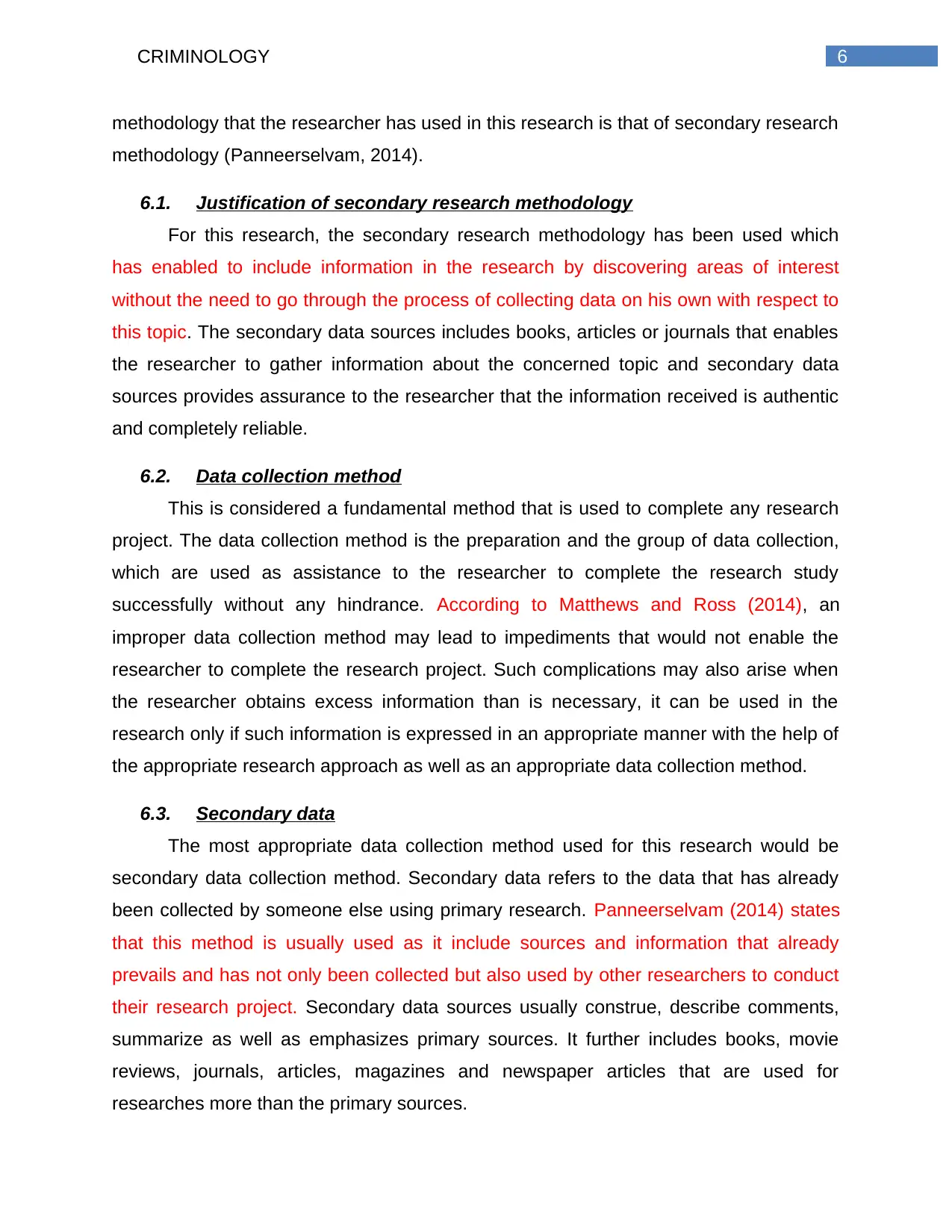
6CRIMINOLOGY
methodology that the researcher has used in this research is that of secondary research
methodology (Panneerselvam, 2014).
6.1. Justification of secondary research methodology
For this research, the secondary research methodology has been used which
has enabled to include information in the research by discovering areas of interest
without the need to go through the process of collecting data on his own with respect to
this topic. The secondary data sources includes books, articles or journals that enables
the researcher to gather information about the concerned topic and secondary data
sources provides assurance to the researcher that the information received is authentic
and completely reliable.
6.2. Data collection method
This is considered a fundamental method that is used to complete any research
project. The data collection method is the preparation and the group of data collection,
which are used as assistance to the researcher to complete the research study
successfully without any hindrance. According to Matthews and Ross (2014), an
improper data collection method may lead to impediments that would not enable the
researcher to complete the research project. Such complications may also arise when
the researcher obtains excess information than is necessary, it can be used in the
research only if such information is expressed in an appropriate manner with the help of
the appropriate research approach as well as an appropriate data collection method.
6.3. Secondary data
The most appropriate data collection method used for this research would be
secondary data collection method. Secondary data refers to the data that has already
been collected by someone else using primary research. Panneerselvam (2014) states
that this method is usually used as it include sources and information that already
prevails and has not only been collected but also used by other researchers to conduct
their research project. Secondary data sources usually construe, describe comments,
summarize as well as emphasizes primary sources. It further includes books, movie
reviews, journals, articles, magazines and newspaper articles that are used for
researches more than the primary sources.
methodology that the researcher has used in this research is that of secondary research
methodology (Panneerselvam, 2014).
6.1. Justification of secondary research methodology
For this research, the secondary research methodology has been used which
has enabled to include information in the research by discovering areas of interest
without the need to go through the process of collecting data on his own with respect to
this topic. The secondary data sources includes books, articles or journals that enables
the researcher to gather information about the concerned topic and secondary data
sources provides assurance to the researcher that the information received is authentic
and completely reliable.
6.2. Data collection method
This is considered a fundamental method that is used to complete any research
project. The data collection method is the preparation and the group of data collection,
which are used as assistance to the researcher to complete the research study
successfully without any hindrance. According to Matthews and Ross (2014), an
improper data collection method may lead to impediments that would not enable the
researcher to complete the research project. Such complications may also arise when
the researcher obtains excess information than is necessary, it can be used in the
research only if such information is expressed in an appropriate manner with the help of
the appropriate research approach as well as an appropriate data collection method.
6.3. Secondary data
The most appropriate data collection method used for this research would be
secondary data collection method. Secondary data refers to the data that has already
been collected by someone else using primary research. Panneerselvam (2014) states
that this method is usually used as it include sources and information that already
prevails and has not only been collected but also used by other researchers to conduct
their research project. Secondary data sources usually construe, describe comments,
summarize as well as emphasizes primary sources. It further includes books, movie
reviews, journals, articles, magazines and newspaper articles that are used for
researches more than the primary sources.
Paraphrase This Document
Need a fresh take? Get an instant paraphrase of this document with our AI Paraphraser
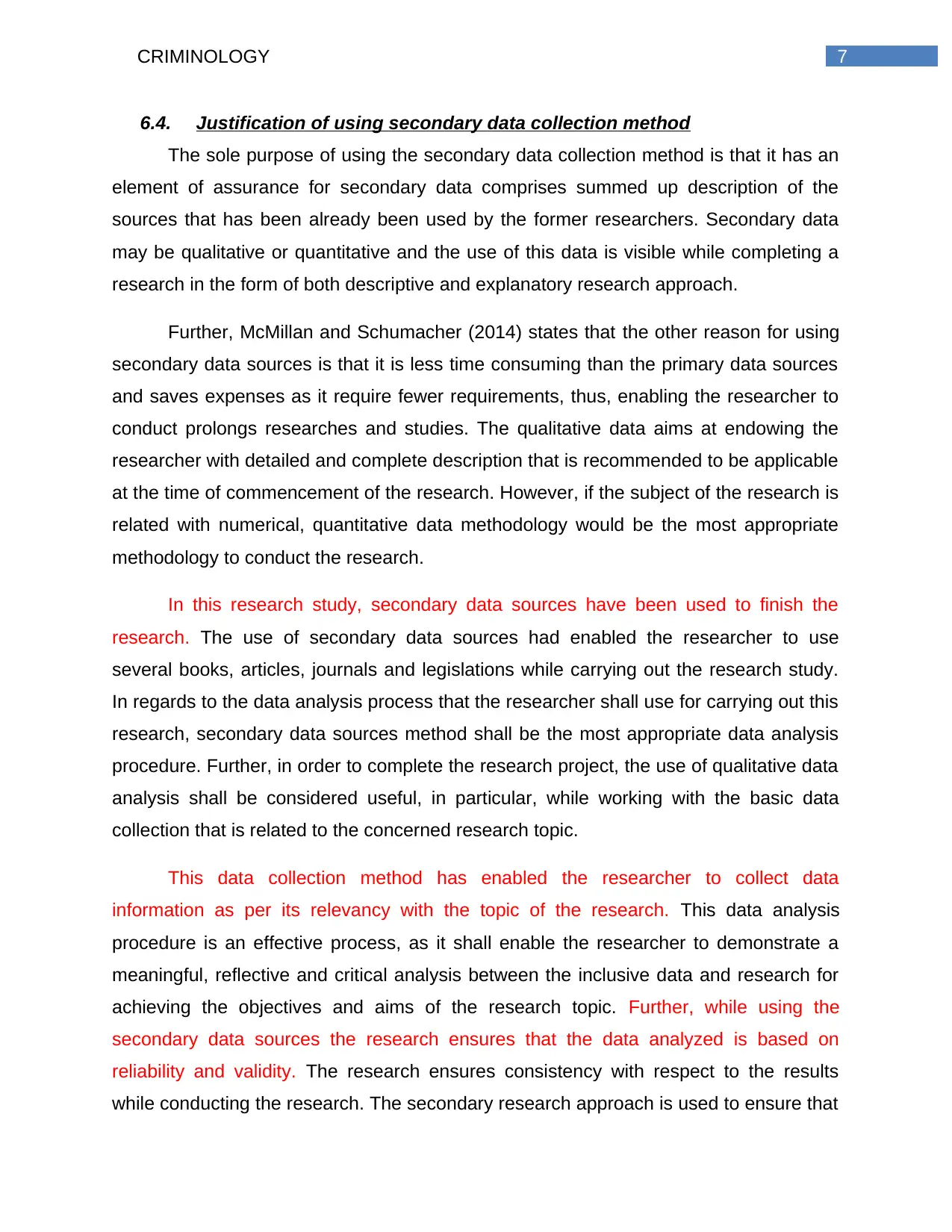
7CRIMINOLOGY
6.4. Justification of using secondary data collection method
The sole purpose of using the secondary data collection method is that it has an
element of assurance for secondary data comprises summed up description of the
sources that has been already been used by the former researchers. Secondary data
may be qualitative or quantitative and the use of this data is visible while completing a
research in the form of both descriptive and explanatory research approach.
Further, McMillan and Schumacher (2014) states that the other reason for using
secondary data sources is that it is less time consuming than the primary data sources
and saves expenses as it require fewer requirements, thus, enabling the researcher to
conduct prolongs researches and studies. The qualitative data aims at endowing the
researcher with detailed and complete description that is recommended to be applicable
at the time of commencement of the research. However, if the subject of the research is
related with numerical, quantitative data methodology would be the most appropriate
methodology to conduct the research.
In this research study, secondary data sources have been used to finish the
research. The use of secondary data sources had enabled the researcher to use
several books, articles, journals and legislations while carrying out the research study.
In regards to the data analysis process that the researcher shall use for carrying out this
research, secondary data sources method shall be the most appropriate data analysis
procedure. Further, in order to complete the research project, the use of qualitative data
analysis shall be considered useful, in particular, while working with the basic data
collection that is related to the concerned research topic.
This data collection method has enabled the researcher to collect data
information as per its relevancy with the topic of the research. This data analysis
procedure is an effective process, as it shall enable the researcher to demonstrate a
meaningful, reflective and critical analysis between the inclusive data and research for
achieving the objectives and aims of the research topic. Further, while using the
secondary data sources the research ensures that the data analyzed is based on
reliability and validity. The research ensures consistency with respect to the results
while conducting the research. The secondary research approach is used to ensure that
6.4. Justification of using secondary data collection method
The sole purpose of using the secondary data collection method is that it has an
element of assurance for secondary data comprises summed up description of the
sources that has been already been used by the former researchers. Secondary data
may be qualitative or quantitative and the use of this data is visible while completing a
research in the form of both descriptive and explanatory research approach.
Further, McMillan and Schumacher (2014) states that the other reason for using
secondary data sources is that it is less time consuming than the primary data sources
and saves expenses as it require fewer requirements, thus, enabling the researcher to
conduct prolongs researches and studies. The qualitative data aims at endowing the
researcher with detailed and complete description that is recommended to be applicable
at the time of commencement of the research. However, if the subject of the research is
related with numerical, quantitative data methodology would be the most appropriate
methodology to conduct the research.
In this research study, secondary data sources have been used to finish the
research. The use of secondary data sources had enabled the researcher to use
several books, articles, journals and legislations while carrying out the research study.
In regards to the data analysis process that the researcher shall use for carrying out this
research, secondary data sources method shall be the most appropriate data analysis
procedure. Further, in order to complete the research project, the use of qualitative data
analysis shall be considered useful, in particular, while working with the basic data
collection that is related to the concerned research topic.
This data collection method has enabled the researcher to collect data
information as per its relevancy with the topic of the research. This data analysis
procedure is an effective process, as it shall enable the researcher to demonstrate a
meaningful, reflective and critical analysis between the inclusive data and research for
achieving the objectives and aims of the research topic. Further, while using the
secondary data sources the research ensures that the data analyzed is based on
reliability and validity. The research ensures consistency with respect to the results
while conducting the research. The secondary research approach is used to ensure that
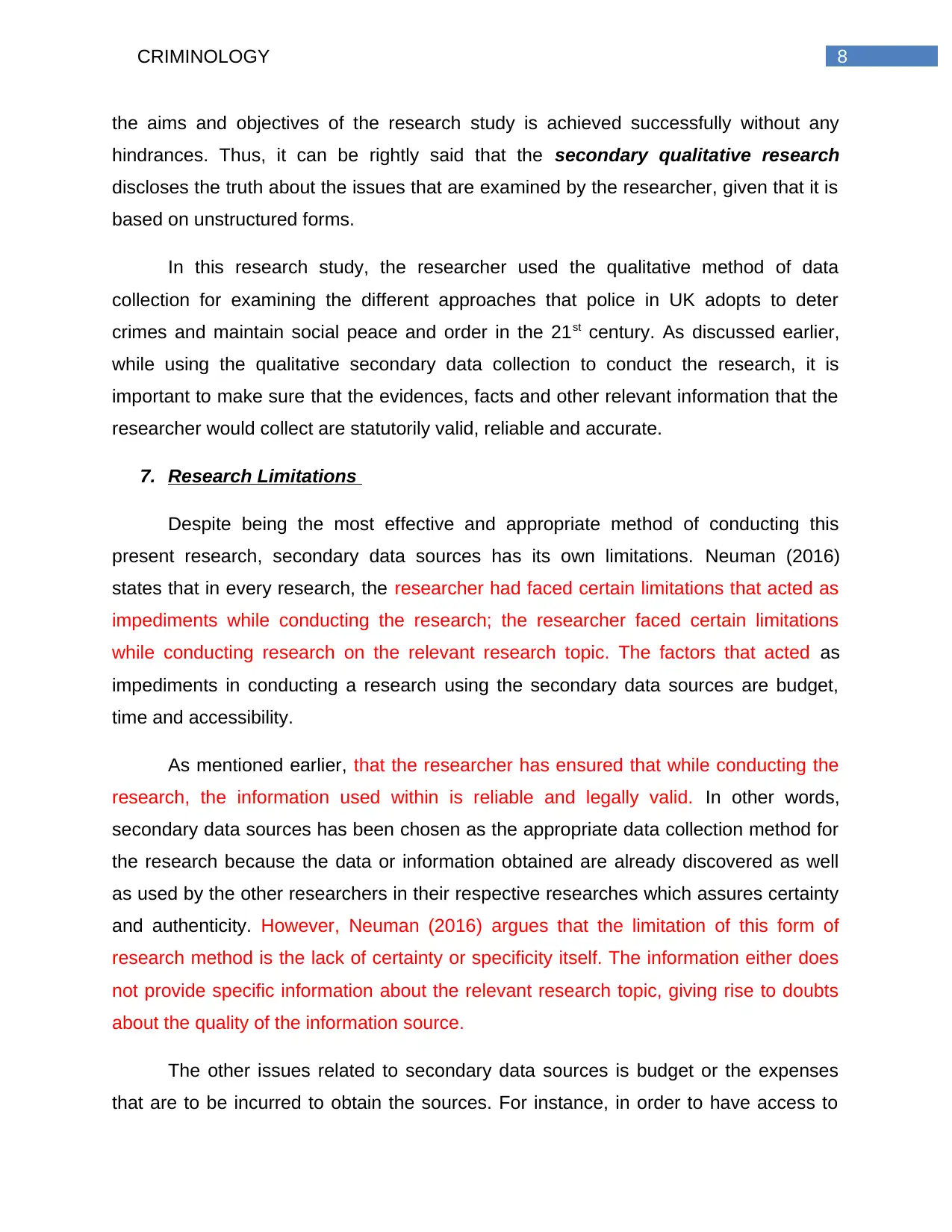
8CRIMINOLOGY
the aims and objectives of the research study is achieved successfully without any
hindrances. Thus, it can be rightly said that the secondary qualitative research
discloses the truth about the issues that are examined by the researcher, given that it is
based on unstructured forms.
In this research study, the researcher used the qualitative method of data
collection for examining the different approaches that police in UK adopts to deter
crimes and maintain social peace and order in the 21st century. As discussed earlier,
while using the qualitative secondary data collection to conduct the research, it is
important to make sure that the evidences, facts and other relevant information that the
researcher would collect are statutorily valid, reliable and accurate.
7. Research Limitations
Despite being the most effective and appropriate method of conducting this
present research, secondary data sources has its own limitations. Neuman (2016)
states that in every research, the researcher had faced certain limitations that acted as
impediments while conducting the research; the researcher faced certain limitations
while conducting research on the relevant research topic. The factors that acted as
impediments in conducting a research using the secondary data sources are budget,
time and accessibility.
As mentioned earlier, that the researcher has ensured that while conducting the
research, the information used within is reliable and legally valid. In other words,
secondary data sources has been chosen as the appropriate data collection method for
the research because the data or information obtained are already discovered as well
as used by the other researchers in their respective researches which assures certainty
and authenticity. However, Neuman (2016) argues that the limitation of this form of
research method is the lack of certainty or specificity itself. The information either does
not provide specific information about the relevant research topic, giving rise to doubts
about the quality of the information source.
The other issues related to secondary data sources is budget or the expenses
that are to be incurred to obtain the sources. For instance, in order to have access to
the aims and objectives of the research study is achieved successfully without any
hindrances. Thus, it can be rightly said that the secondary qualitative research
discloses the truth about the issues that are examined by the researcher, given that it is
based on unstructured forms.
In this research study, the researcher used the qualitative method of data
collection for examining the different approaches that police in UK adopts to deter
crimes and maintain social peace and order in the 21st century. As discussed earlier,
while using the qualitative secondary data collection to conduct the research, it is
important to make sure that the evidences, facts and other relevant information that the
researcher would collect are statutorily valid, reliable and accurate.
7. Research Limitations
Despite being the most effective and appropriate method of conducting this
present research, secondary data sources has its own limitations. Neuman (2016)
states that in every research, the researcher had faced certain limitations that acted as
impediments while conducting the research; the researcher faced certain limitations
while conducting research on the relevant research topic. The factors that acted as
impediments in conducting a research using the secondary data sources are budget,
time and accessibility.
As mentioned earlier, that the researcher has ensured that while conducting the
research, the information used within is reliable and legally valid. In other words,
secondary data sources has been chosen as the appropriate data collection method for
the research because the data or information obtained are already discovered as well
as used by the other researchers in their respective researches which assures certainty
and authenticity. However, Neuman (2016) argues that the limitation of this form of
research method is the lack of certainty or specificity itself. The information either does
not provide specific information about the relevant research topic, giving rise to doubts
about the quality of the information source.
The other issues related to secondary data sources is budget or the expenses
that are to be incurred to obtain the sources. For instance, in order to have access to
⊘ This is a preview!⊘
Do you want full access?
Subscribe today to unlock all pages.

Trusted by 1+ million students worldwide
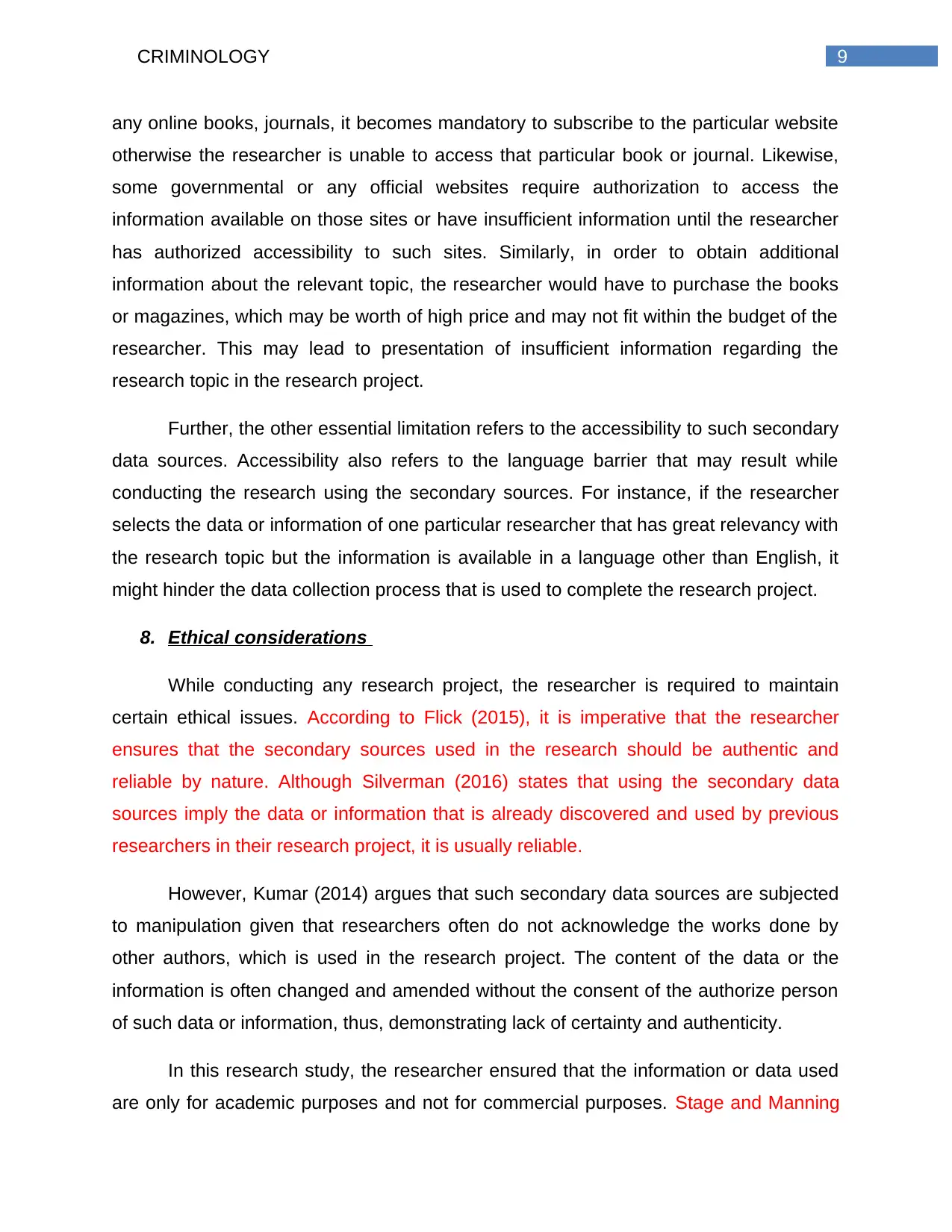
9CRIMINOLOGY
any online books, journals, it becomes mandatory to subscribe to the particular website
otherwise the researcher is unable to access that particular book or journal. Likewise,
some governmental or any official websites require authorization to access the
information available on those sites or have insufficient information until the researcher
has authorized accessibility to such sites. Similarly, in order to obtain additional
information about the relevant topic, the researcher would have to purchase the books
or magazines, which may be worth of high price and may not fit within the budget of the
researcher. This may lead to presentation of insufficient information regarding the
research topic in the research project.
Further, the other essential limitation refers to the accessibility to such secondary
data sources. Accessibility also refers to the language barrier that may result while
conducting the research using the secondary sources. For instance, if the researcher
selects the data or information of one particular researcher that has great relevancy with
the research topic but the information is available in a language other than English, it
might hinder the data collection process that is used to complete the research project.
8. Ethical considerations
While conducting any research project, the researcher is required to maintain
certain ethical issues. According to Flick (2015), it is imperative that the researcher
ensures that the secondary sources used in the research should be authentic and
reliable by nature. Although Silverman (2016) states that using the secondary data
sources imply the data or information that is already discovered and used by previous
researchers in their research project, it is usually reliable.
However, Kumar (2014) argues that such secondary data sources are subjected
to manipulation given that researchers often do not acknowledge the works done by
other authors, which is used in the research project. The content of the data or the
information is often changed and amended without the consent of the authorize person
of such data or information, thus, demonstrating lack of certainty and authenticity.
In this research study, the researcher ensured that the information or data used
are only for academic purposes and not for commercial purposes. Stage and Manning
any online books, journals, it becomes mandatory to subscribe to the particular website
otherwise the researcher is unable to access that particular book or journal. Likewise,
some governmental or any official websites require authorization to access the
information available on those sites or have insufficient information until the researcher
has authorized accessibility to such sites. Similarly, in order to obtain additional
information about the relevant topic, the researcher would have to purchase the books
or magazines, which may be worth of high price and may not fit within the budget of the
researcher. This may lead to presentation of insufficient information regarding the
research topic in the research project.
Further, the other essential limitation refers to the accessibility to such secondary
data sources. Accessibility also refers to the language barrier that may result while
conducting the research using the secondary sources. For instance, if the researcher
selects the data or information of one particular researcher that has great relevancy with
the research topic but the information is available in a language other than English, it
might hinder the data collection process that is used to complete the research project.
8. Ethical considerations
While conducting any research project, the researcher is required to maintain
certain ethical issues. According to Flick (2015), it is imperative that the researcher
ensures that the secondary sources used in the research should be authentic and
reliable by nature. Although Silverman (2016) states that using the secondary data
sources imply the data or information that is already discovered and used by previous
researchers in their research project, it is usually reliable.
However, Kumar (2014) argues that such secondary data sources are subjected
to manipulation given that researchers often do not acknowledge the works done by
other authors, which is used in the research project. The content of the data or the
information is often changed and amended without the consent of the authorize person
of such data or information, thus, demonstrating lack of certainty and authenticity.
In this research study, the researcher ensured that the information or data used
are only for academic purposes and not for commercial purposes. Stage and Manning
Paraphrase This Document
Need a fresh take? Get an instant paraphrase of this document with our AI Paraphraser

10CRIMINOLOGY
(2015) argues that often researchers uses the data or information that belonged to
some other researcher as his own for monetary gains. Therefore, the researcher
ensured that the research project is completed using the secondary sources that is both
authentic and reliable.
(2015) argues that often researchers uses the data or information that belonged to
some other researcher as his own for monetary gains. Therefore, the researcher
ensured that the research project is completed using the secondary sources that is both
authentic and reliable.
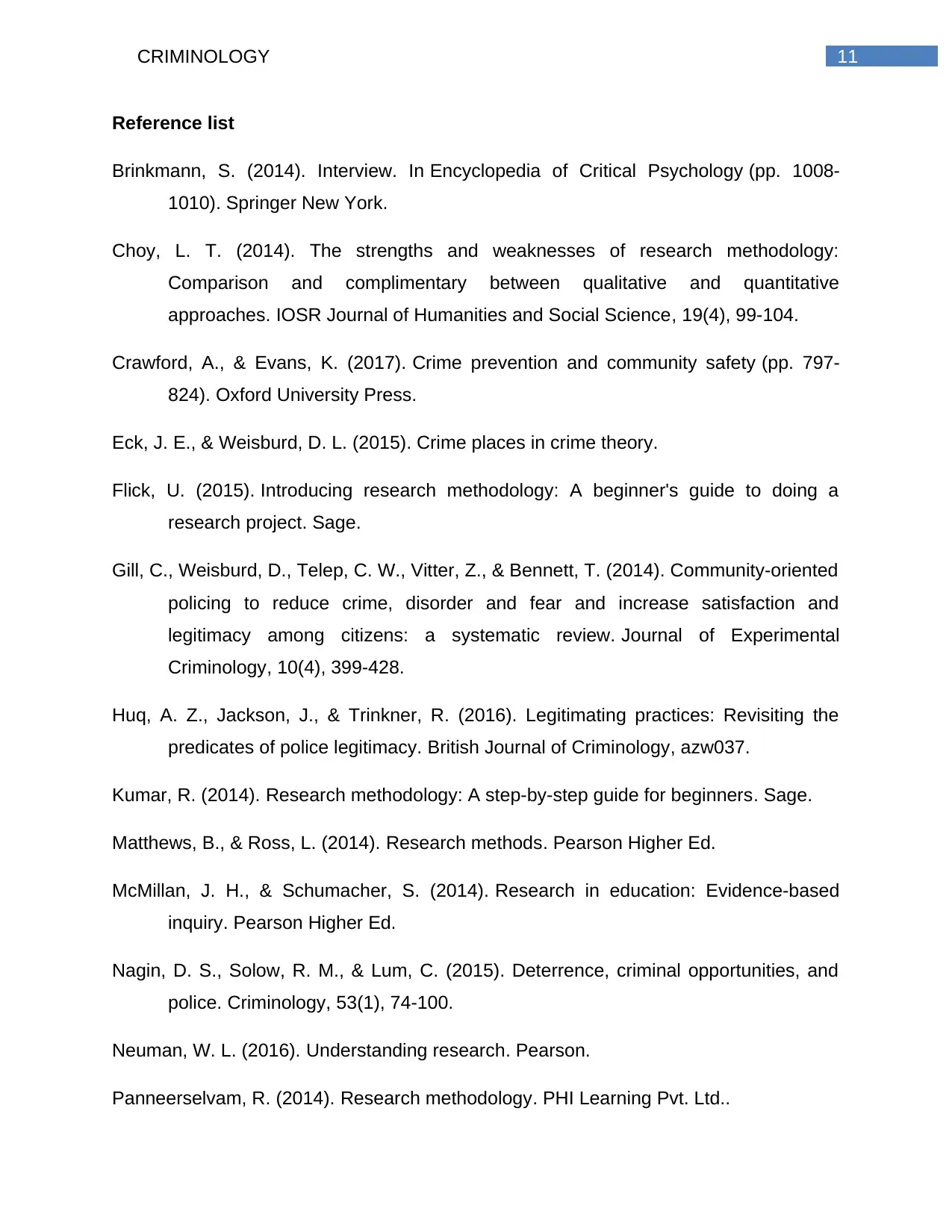
11CRIMINOLOGY
Reference list
Brinkmann, S. (2014). Interview. In Encyclopedia of Critical Psychology (pp. 1008-
1010). Springer New York.
Choy, L. T. (2014). The strengths and weaknesses of research methodology:
Comparison and complimentary between qualitative and quantitative
approaches. IOSR Journal of Humanities and Social Science, 19(4), 99-104.
Crawford, A., & Evans, K. (2017). Crime prevention and community safety (pp. 797-
824). Oxford University Press.
Eck, J. E., & Weisburd, D. L. (2015). Crime places in crime theory.
Flick, U. (2015). Introducing research methodology: A beginner's guide to doing a
research project. Sage.
Gill, C., Weisburd, D., Telep, C. W., Vitter, Z., & Bennett, T. (2014). Community-oriented
policing to reduce crime, disorder and fear and increase satisfaction and
legitimacy among citizens: a systematic review. Journal of Experimental
Criminology, 10(4), 399-428.
Huq, A. Z., Jackson, J., & Trinkner, R. (2016). Legitimating practices: Revisiting the
predicates of police legitimacy. British Journal of Criminology, azw037.
Kumar, R. (2014). Research methodology: A step-by-step guide for beginners. Sage.
Matthews, B., & Ross, L. (2014). Research methods. Pearson Higher Ed.
McMillan, J. H., & Schumacher, S. (2014). Research in education: Evidence-based
inquiry. Pearson Higher Ed.
Nagin, D. S., Solow, R. M., & Lum, C. (2015). Deterrence, criminal opportunities, and
police. Criminology, 53(1), 74-100.
Neuman, W. L. (2016). Understanding research. Pearson.
Panneerselvam, R. (2014). Research methodology. PHI Learning Pvt. Ltd..
Reference list
Brinkmann, S. (2014). Interview. In Encyclopedia of Critical Psychology (pp. 1008-
1010). Springer New York.
Choy, L. T. (2014). The strengths and weaknesses of research methodology:
Comparison and complimentary between qualitative and quantitative
approaches. IOSR Journal of Humanities and Social Science, 19(4), 99-104.
Crawford, A., & Evans, K. (2017). Crime prevention and community safety (pp. 797-
824). Oxford University Press.
Eck, J. E., & Weisburd, D. L. (2015). Crime places in crime theory.
Flick, U. (2015). Introducing research methodology: A beginner's guide to doing a
research project. Sage.
Gill, C., Weisburd, D., Telep, C. W., Vitter, Z., & Bennett, T. (2014). Community-oriented
policing to reduce crime, disorder and fear and increase satisfaction and
legitimacy among citizens: a systematic review. Journal of Experimental
Criminology, 10(4), 399-428.
Huq, A. Z., Jackson, J., & Trinkner, R. (2016). Legitimating practices: Revisiting the
predicates of police legitimacy. British Journal of Criminology, azw037.
Kumar, R. (2014). Research methodology: A step-by-step guide for beginners. Sage.
Matthews, B., & Ross, L. (2014). Research methods. Pearson Higher Ed.
McMillan, J. H., & Schumacher, S. (2014). Research in education: Evidence-based
inquiry. Pearson Higher Ed.
Nagin, D. S., Solow, R. M., & Lum, C. (2015). Deterrence, criminal opportunities, and
police. Criminology, 53(1), 74-100.
Neuman, W. L. (2016). Understanding research. Pearson.
Panneerselvam, R. (2014). Research methodology. PHI Learning Pvt. Ltd..
⊘ This is a preview!⊘
Do you want full access?
Subscribe today to unlock all pages.

Trusted by 1+ million students worldwide
1 out of 13
Related Documents
Your All-in-One AI-Powered Toolkit for Academic Success.
+13062052269
info@desklib.com
Available 24*7 on WhatsApp / Email
![[object Object]](/_next/static/media/star-bottom.7253800d.svg)
Unlock your academic potential
Copyright © 2020–2025 A2Z Services. All Rights Reserved. Developed and managed by ZUCOL.





